| Article ID | Journal | Published Year | Pages | File Type |
|---|---|---|---|---|
| 6486666 | Biotechnology Advances | 2018 | 46 Pages |
Abstract
Glycopeptide antibiotics are drugs of last resort for treating severe infections caused by multi-drug resistant Gram-positive pathogens. First-generation glycopeptides (vancomycin and teicoplanin) are produced by soil-dwelling actinomycetes. Second-generation glycopeptides (dalbavancin, oritavancin, and telavancin) are semi-synthetic derivatives of the progenitor natural products. Herein, we cover past and present biotechnological approaches for searching for and producing old and new glycopeptide antibiotics. We review the strategies adopted to increase microbial production (from classical strain improvement to rational genetic engineering), and the recent progress in genome mining, chemoenzymatic derivatization, and combinatorial biosynthesis for expanding glycopeptide chemical diversity and tackling the never-ceasing evolution of antibiotic resistance.
Keywords
UDPHPGVREDHPGGTFMNNGGPAMtFCSITDPATFVPAPDHRNAPNRPSBGCGlcNAcppGppAcyltransferaseteicoplaninDalbavancinDAHPNGSSTFNDPFDAA40926d-alanyl-d-alanine3-deoxy-d-arabino-heptulosonate-7-phosphate synthasenuclear magnetic resonanceN-methyl-N′-nitro-N-nitrosoguanidineuridine diphosphateRNA polymeraseGlycopeptide antibioticGlycopeptide antibioticsStaphylococcus aureusMRSAmethicillin-resistant Staphylococcus aureusVancomycin-resistant enterococcidissolved oxygenStrain improvementFermentationNMRNext-generation sequencingThiamine diphosphateBiosynthetic gene clusternucleotide diphosphatedihydroxyphenylglycineRifampicin resistanceFood and Drug AdministrationsulfotransferaseMethyltransferaseGenetic engineeringN-acetylglucosamineVancomycinPrephenate dehydrogenaseNonribosomal peptide synthetasePeptidoglycanHPLChigh-performance liquid chromatographyGlycosyltransferaseGuanosine tetraphosphate
Related Topics
Physical Sciences and Engineering
Chemical Engineering
Bioengineering
Authors
Giorgia Letizia Marcone, Elisa Binda, Francesca Berini, Flavia Marinelli,
